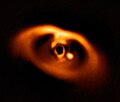
A blanet is a member of a hypothetical class of exoplanets that directly orbit black holes. [1]
Contents
Blanets are fundamentally similar to other planets; they have enough mass to be rounded by their own gravity, but are not massive enough to start thermonuclear fusion and become stars. In 2019, a team of astronomers and exoplanetologists showed that there is a safe zone around a supermassive black hole that could harbor thousands of blanets in orbit around it. [2] [3]
